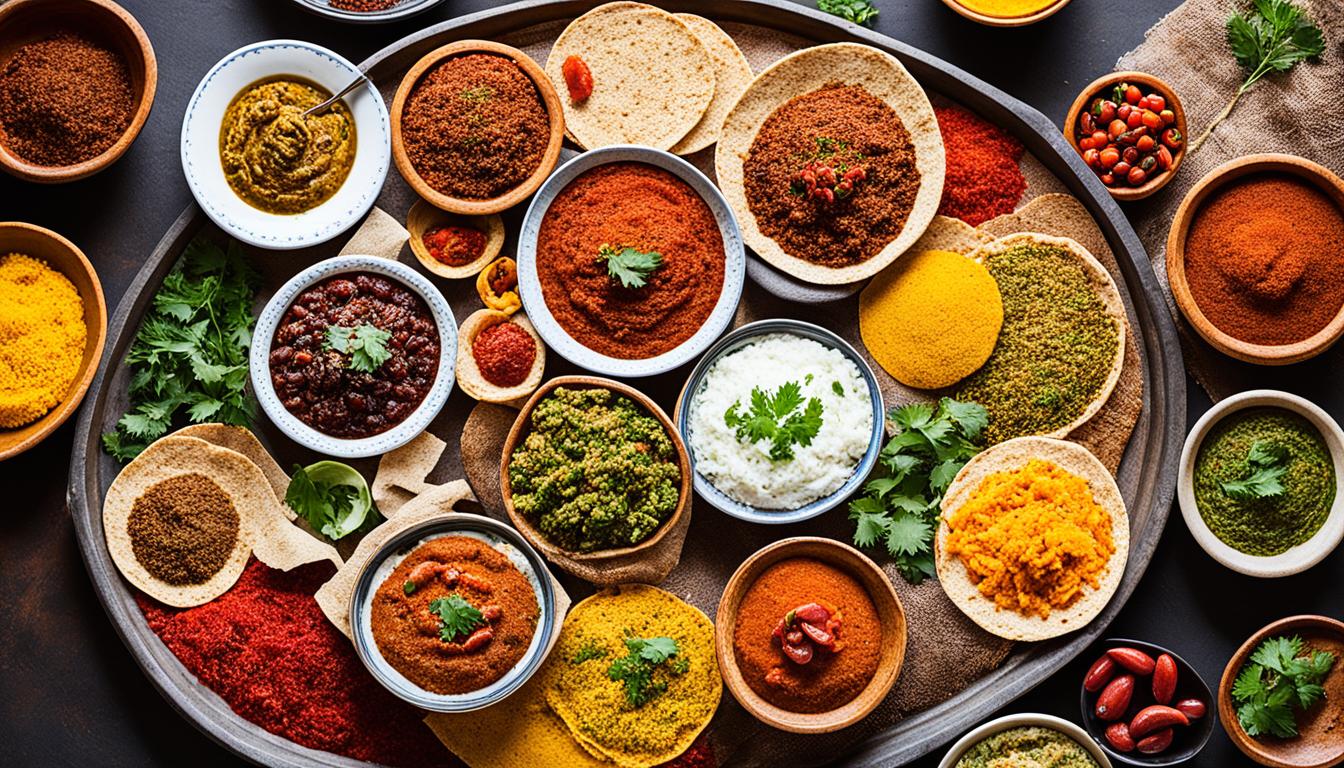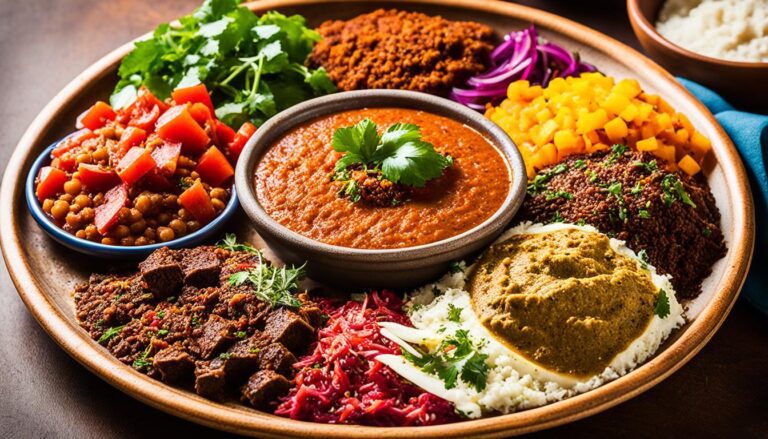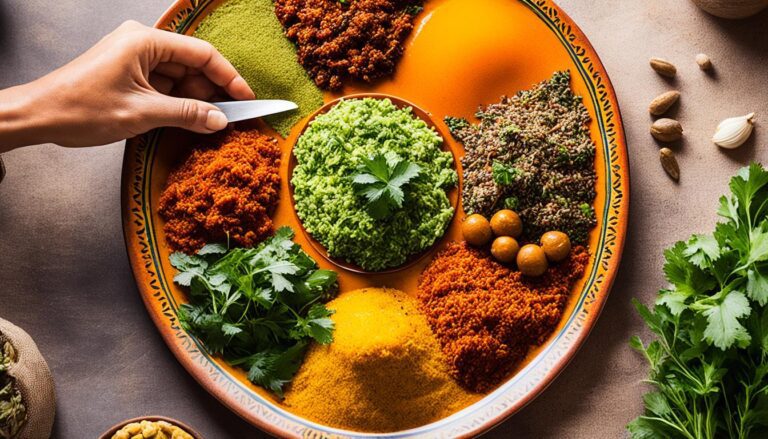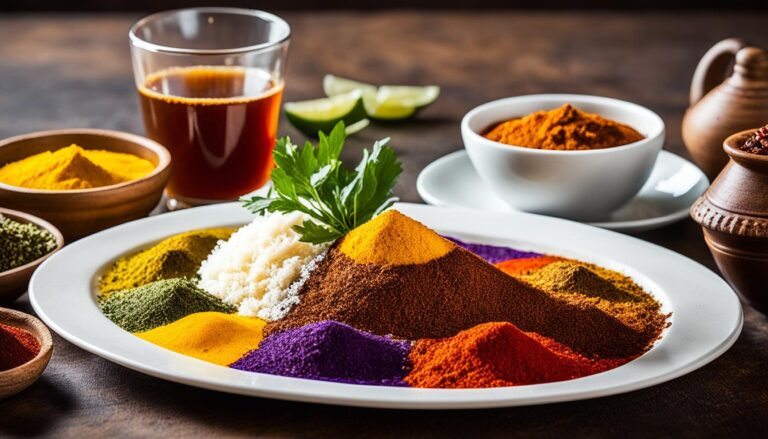Where Did Ethiopian Food Come From?
Have you ever wondered about the origins of Ethiopian food? The rich tapestry of flavors and unique culinary traditions have captivated taste buds around the world. But how did this vibrant cuisine come to be? Join us on a journey through history as we delve into the origins, history, and flavors of traditional Ethiopian dishes.
Key Takeaways:
- Ethiopian cuisine is a result of centuries of fusion and adaptation, influenced by Indian, Portuguese, and East Asian spices and ingredients.
- Indigenous grains like teff, sorghum, millet, and wheat form the base of many Ethiopian dishes.
- Berbere, a spice blend, is a key seasoning in Ethiopian cuisine, adding heat and depth to dishes.
- Injera, a sour fermented teff flour bread, is a staple in Ethiopian meals and is used as both a utensil and a base for dishes.
- The Aksumite culture played a significant role in shaping Ethiopian cuisine, cultivating indigenous grains and indulging in feasts.
The History of Ethiopian Cuisine
Ethiopian cuisine is deeply intertwined with the rich history of the region, showcasing a fusion of flavors that have evolved over centuries. The culinary journey of Ethiopian food can be traced back to ancient times, where indigenous grains like teff, sorghum, and millet were cultivated in the fertile highlands of western Eritrea and Sudan as early as the fourth millennium B.C.
These indigenous grains, along with a variety of vegetables and pulses, formed the backbone of the early Ethiopian diet. However, as Ethiopia became a hub for trade along ancient spice routes, the country’s culinary landscape began to change.
Foreign spices from India, such as cumin and turmeric, chile peppers from Portugal, and ginger from East Asian countries found their way to Ethiopian shores. These introduced spices and ingredients melded with the native grains and proteins, giving birth to the distinct and vibrant flavors that define Ethiopian cuisine today.
Pic: Using indigenous grains and influenced by foreign spices, Ethiopian cuisine offers unique and vibrant flavors.
This blending of culinary influences is exemplified in one of the key seasonings of Ethiopian cuisine, berbere. Berbere is a spice blend incorporating ingredients like chile peppers, fenugreek, cinnamon, ginger, and more. It adds heat and depth to dishes, contributing to the unique taste of Ethiopian food.
The history of Ethiopian cuisine is a testament to the country’s vibrant culture and deep connection with its land. The use of indigenous grains and the influence of foreign spices have shaped Ethiopian culinary traditions, making it a truly remarkable and flavorful experience.
What Ethiopian Food Tastes Like

Ethiopian food is a delightful explosion of flavors that will tantalize your taste buds. The cuisine combines a unique blend of earthy, spicy, tart, sour, and pungent tastes, creating a harmonious culinary experience like no other.
One of the key elements that contribute to the distinctive flavors of Ethiopian cuisine is the traditional spice blend known as Berbere. This aromatic seasoning typically includes chile peppers, fenugreek, cinnamon, ginger, cardamom, and coriander. The combination of these spices adds a rich depth and fiery heat to Ethiopian dishes.
In addition to the famous Berbere seasoning, Ethiopian cuisine is also characterized by the use of garlic, onion, and ginger, which add their own unique flavors and aromas. Various herbs and spices, such as cumin, cloves, and turmeric, are also commonly used to enhance the taste profiles of different dishes.
The result is a vibrant and complex tapestry of flavors that dance on your palate, offering a truly memorable culinary experience. Whether you’re savoring the heat of a spicy stew or relishing the tangy notes of a zesty salad, Ethiopian food will take you on a mouthwatering journey that is both satisfying and unforgettable.
Traditional Ethiopian Dishes
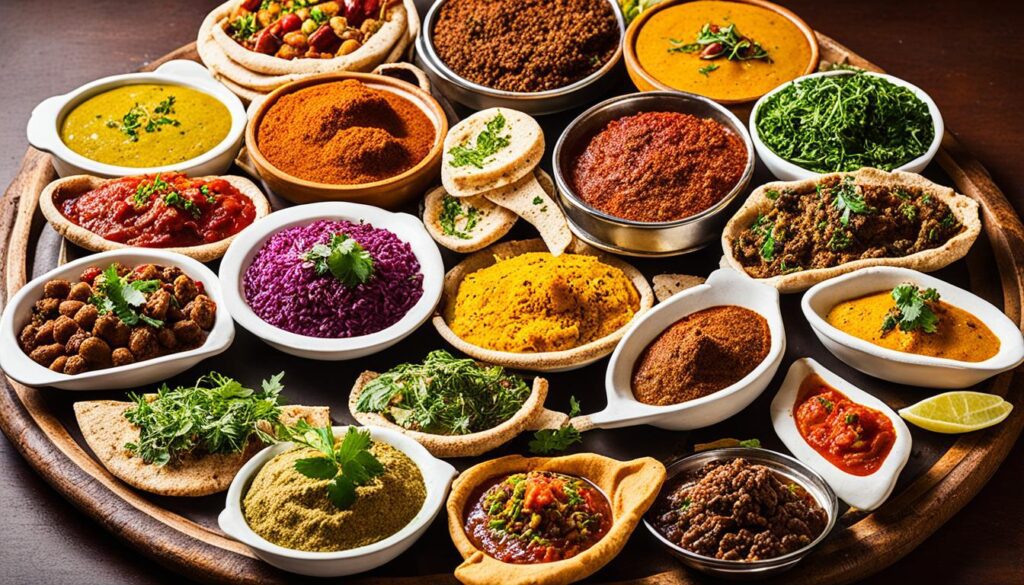
Ethiopian cuisine offers a variety of traditional dishes that showcase the flavors and ingredients of the region. Some popular Ethiopian dishes include:
Doro Wat
Doro Wat is a spicy chicken stew that is considered the national dish of Ethiopia. It is made with chicken marinated in a blend of spices, such as berbere, onions, garlic, and ginger. The stew is slow-cooked to perfection, resulting in tender and flavorful chicken.
Tibs
Tibs is a dish made with marinated and sautéed meat, typically beef or lamb. The meat is cooked with onions, peppers, and spices, resulting in a savory and aromatic dish. Tibs can be served with injera, the traditional Ethiopian bread, or rice.
Kitfo
Kitfo is a traditional Ethiopian dish made from minced raw beef, seasoned with spices and herbs. It is often served with injera and a side of cheese and greens. Kitfo is a must-try for those who enjoy adventurous and unique flavors.
Misir Wat
Misir Wat is a spicy lentil stew that is a staple in Ethiopian cuisine. It is made with red lentils cooked with berbere spice blend, onions, garlic, and ginger. Misir Wat is rich in flavor and is perfect for vegetarians and vegans.
These are just a few examples of the many delicious traditional dishes that are popular in Ethiopian cuisine. Each dish offers a unique blend of flavors and spices that represent the rich culinary heritage of Ethiopia.
The Role of Teff in Ethiopian Cuisine
Teff, a gluten-free grain indigenous to Ethiopia, plays a significant role in Ethiopian cuisine. It is the main ingredient in injera, a sour fermented bread that serves as a staple in Ethiopian meals.
Injera is made by fermenting teff flour and cooking it on a large round skillet called a mitad. The batter is poured onto the skillet and cooked until it forms a large flatbread with a spongy texture.
Injera serves as both a utensil and a base for Ethiopian dishes. It is torn into pieces and used to scoop up bites of food, allowing for a unique and interactive dining experience.
The Influence of Aksumite Culture on Ethiopian Cuisine
The Aksumite culture, which flourished from the first century B.C. to the eighth century A.D., had a profound impact on Ethiopian cuisine. The Aksumites cultivated crops such as teff, wheat, barley, and other grains that became essential staples in the Ethiopian diet. Their culinary practices laid the foundation for the traditional Ethiopian cuisine we know today.
The Aksumite royalty indulged in lavish feasts, as depicted in ancient inscriptions on Aksumite stones, translated by scholars. These feasts featured a variety of dishes, including virgin mutton, beef, honey, wheat, bread, and honey wine. The consumption of t’ej, a traditional honey wine, and beer was also enjoyed by the Aksumites, further contributing to their unique culinary practices.
The Aksumite influence on Ethiopian cuisine is a testament to the cultural heritage and rich history of the region. The cultivation of indigenous grains and the consumption of distinct dishes and beverages have been passed down through generations, preserving the traditions and flavors that define Ethiopian food today.
Ethiopian Cuisine Through the Centuries
Over the centuries, Ethiopian cuisine has undergone a fascinating evolution, intertwining with diverse culinary influences and embracing modern techniques while staying true to its roots. Evolution of Ethiopian food has been shaped by various factors including trade, colonization, and cultural interactions. European traders who arrived in Ethiopia during the 16th century brought with them new ingredients such as red pepper and black pepper, which infused a spicy kick into traditional Ethiopian dishes.
European visitors also introduced pasta to Ethiopia, leading to its integration into the local cuisine. Today, you can find pasta dishes even in rural areas, showcasing the fusion of culinary influences that have shaped modern Ethiopian cuisine.
The blending of traditional Ethiopian flavors with these new ingredients gave rise to the development of innovative dishes and flavors that have become integral to Ethiopian cuisine. This fusion of culinary influences has resulted in a diverse culinary landscape, offering a wide range of both traditional and modern dishes to savor.
Ethiopian cuisine continues to evolve with the incorporation of modern culinary techniques and international culinary influences. Chefs and cooks are experimenting with new flavors, textures, and presentations while honoring the essence of Ethiopian food. The result is a vibrant and dynamic culinary scene that showcases the rich heritage of Ethiopian cuisine in a contemporary context.
Despite these modern influences, Ethiopian cuisine remains deeply rooted in its origins, maintaining the unique flavors, traditional dishes, and dining customs that have been cherished for centuries. Whether you are enjoying a classic Ethiopian injera and doro wat or exploring innovative reinterpretations of Ethiopian dishes, the richness and diversity of Ethiopian cuisine are sure to captivate your taste buds and provide a memorable dining experience.
Conclusion
Ethiopian cuisine is a culinary heritage deeply rooted in the history and culture of the region. The diverse flavors of Ethiopian food, with their unique blend of spices and indigenous ingredients, offer a truly memorable dining experience. From the tangy injera to the aromatic stews and spicy seasonings, Ethiopian cuisine showcases the rich tapestry of tastes that have evolved over centuries.
Whether you choose to explore Ethiopian cuisine in a local restaurant or try your hand at cooking traditional dishes at home, you are embarking on a flavorful journey through the origins of Ethiopian food. The bold and vibrant flavors of Ethiopian cuisine reflect a deep sense of tradition and pride in the country’s food heritage.
Indulge in the flavors of Ethiopia and savor the richness of this ancient culinary tradition. Let the aromatic spices, hearty stews, and communal dining experience transport you to the vibrant streets of Addis Ababa. Enjoy the bold flavors of berbere, the earthy taste of injera, and the unique blend of spices that make Ethiopian cuisine a delight for the senses. Whether you are a seasoned food enthusiast or a curious explorer of flavors, the Ethiopian dining experience promises to leave a lasting impression.

